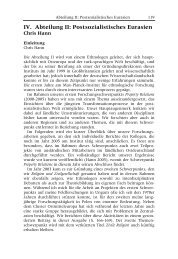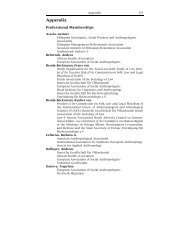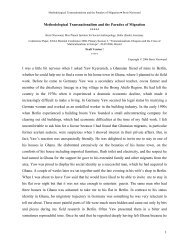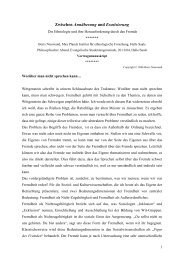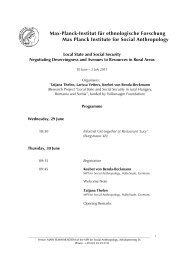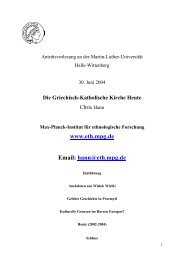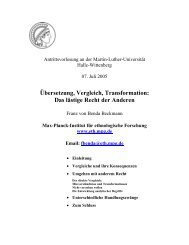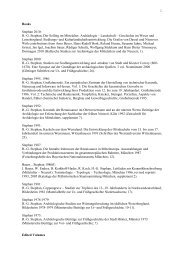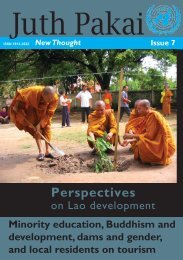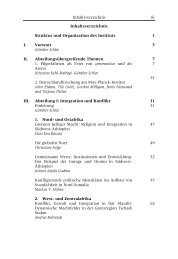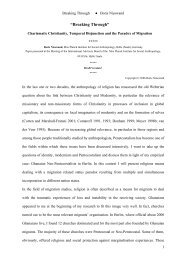ETHNOPOLITICS AND GAbRA ORIGINS - Max-Planck-Institut für ...
ETHNOPOLITICS AND GAbRA ORIGINS - Max-Planck-Institut für ...
ETHNOPOLITICS AND GAbRA ORIGINS - Max-Planck-Institut für ...
You also want an ePaper? Increase the reach of your titles
YUMPU automatically turns print PDFs into web optimized ePapers that Google loves.
Boran as its two ritual centres, the gada system of the Boran as a time giver for periodic<br />
pilgrimages to the Boran and as the core of a joint politico-military alliance that comprised many<br />
groups of PRS origin, some of whom had adopted the Oromo language, others of whom had<br />
remained bilingual or continued to prefer Somaloid dialects 15 . My account comprises all these<br />
different peoples rather than focusing on one of them, precisely because it is ‘regional’ in character.<br />
These remarks do not exhaust the importance of gada institutions for interethnic relations. To<br />
enrich Kassam’s “regional” perspective it should also be mentioned that, apart from modern type<br />
Muslim Somali, all former member groups of the Worr Libin alliance have gada systems, with the<br />
five Gabra Malbe phratries alone having three markedly different ones. But the fact that they all<br />
have gada systems is a true regional phenomenon. This observation, however, says nothing about<br />
whether the Gabra are more Oromo or more Somaloid. My analysis (Schlee 1989: 73–90) shows<br />
that generation set systems of the gada type are common heritage to all speakers of Lowland East<br />
Cushitic (or even East Cushitic) languages, and have not recently been borrowed by one branch<br />
from the other 16 . As remnants show, the Somali also may have had a gada system, and dropped it<br />
in the course of Islamisation 17 .<br />
Kassam makes a great deal of those Gabra lineages, which are of Boran origin, although these are<br />
a numerical minority. One of her prime examples is the Berre lineage of the Alganna phratry<br />
(Kassam 2006: 178). I render a Gabra account of the Boran origin of this lineage as well, slightly<br />
longer, but basically agreeing with Kassam’s version (Schlee 1989: 200). Kassam (ibid.) then goes<br />
The emergent Oromo orthography in Ethiopia, still rich in variation, is full of such debatable duplications of<br />
letters. The Boran dialect in Kenya has been reduced to writing on a very high level of scholarship and<br />
consistency, as can be seen from Houghton’s translation of the Bible. Unfortunately no models have been<br />
derived from this for the Ethiopian attempts to write Oromo in Latin characters. In our collection of Boran<br />
proverbs (2007), Abdullahi Shongolo and I had to follow the Kenyan conventions because the Ethiopian ones<br />
(also adopted by Kassam) are disliked by many Boran speakers, also because of inconsistencies with other<br />
languages used for writing. The use of dh rather than d’ for the postalveolar retroflex contrasts with the use of<br />
that combination of letters in Swahili, in which it stands for a dental fricative. Also in English transcriptions<br />
of non-English words dh is used for the same sound as in Swahili, dhikr (above) being one example.<br />
15 For the different combinations of “Language and Ethnicity,” refer to the entry under that title in the<br />
International Encyclopedia of the Social & Behavioral Sciences (2001) where I use the Garre, a group of the<br />
Worr Libin cluster, as an example.<br />
16 A comparison of gada systems reveals similarities in certain principles in combination with a high level of<br />
difference. The shared principles include being based on rigid numerical calculations and complex calendars,<br />
in contrast to Nilotic generation set systems. The differences extend to such fundamental features of<br />
organisation as the number of sets per generation. To explain the high level of difference, one may point to<br />
the apparent antiquity of these systems, which has allowed them plenty of time to evolve apart. Another<br />
explanation has to do with their distribution in a contiguous area and how this may have come about. In<br />
addition to ritual and the regulation of marriage, to which many gada systems were reduced during the<br />
colonial period, gada was also a mode of military recruitment. The menace of neighbours who had a wellfunctioning<br />
gada system might therefore induce people to set up one such system as well in defence. In spite<br />
of the often observed tendency that enemies become like each other, one might then not choose an identical<br />
gada system but rather mark the enmity to one’s neighbours by some conspicuous differences. The<br />
emergence of gada systems might therefore be seen in a context of warlike interaction. In periods of peace,<br />
people then interact through their gada systems as well and even establish forms of ritual interdependence.<br />
For these we have cited some examples above.<br />
17 Dereje Feyissa (personal communication) has directed my attention to the fact that no pan-gada culture has<br />
ever been ideologically promoted to connect the Oromo to their neighbours in the modern political context.<br />
Given the fact that almost everything from language to religion and former political affiliation is used for<br />
identity construction, this failure to base wider alliances on having or having had gada systems is indeed<br />
remarkable in view of the fact that the Oromo are proud of gada as a “democratic” system in contrast to the<br />
hierarchical model of Abyssinian kinship and the fact that gada is a truly regional phenomenon, as already<br />
the title of Jensen’s (1936) book suggests. Maybe the circumstance that some of the groups perceived as<br />
enemies of the Oromo also have or have had gada systems makes these unsuitable for wider identity<br />
constructions by Oromo nationalists.<br />
7



